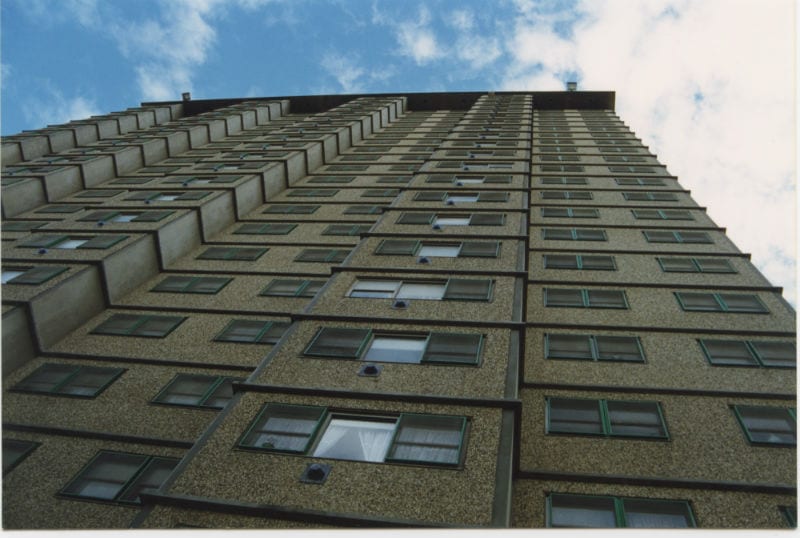VCA Digital Archive: Towering storeys

The VCA Digital Archive is a living audiovisual record of student films that date back to 1966. The articles in this series respond thematically to the depth and breadth of the collection, which will be available for research from mid-2019. Enjoy!
By Yvette Grant
The first public housing towers were built in Melbourne in the late 1960s.
The now fifty-year history of these towers is critically and intimately captured in five short films in the VCA Film Archive.
These films represent important cultural documents recording the response to government policy, as well as the social reality of those most directly affected by that policy: the tenants themselves.
Fitzroy: Coming Up For Air. Peter Dodds. 1970. Documentary.
Fitzroy: Coming Up For Air (1970) is a black and white documentary directed by Peter Dodds, who has enjoyed a prolific 30-year career directing and producing numerous television series, including A Country Practice and Neighbours, and has won national and international awards for Best Serial Drama and Best Foreign Soap.
Directed early on in Dodds’ career, this film interviews soon-to-be tenants as well as local clergy, councillors and administrators about the newly-built towers in Fitzroy.
In a montage of these collective voices interspersed with scenes of the building site and local area, the film records the official story of the relocation of the poor (mostly migrant families and the elderly) out of slum houses and into clean new flats.
But it also records the unofficial story of forcibly moving reluctant tenants not from slum houses but from attractive old terrace houses ripe for renovation and profit.
Life at the Top. Melissa Juhanson. 1990. Documentary.
In Life at the Top (1990), the Carlton towers have now been inhabited for about 20 years and we are invited into the lives of some of their tenants.
They are mostly elderly: most are happy, some are okay, some are preoccupied, and one has a number of visiting pigeons.
The mood is generally joyful, with smiles, music, theatre and dancing, including a finale performance of Welcome to our World.
But while we note a sense of community with tenants gathering for bingo, tea, knitting and cards, we also see hints at lack of sufficient language skills, health problems and the fight against loneliness and social isolation.
Melissa Juhanson’s film is a celebration, a performance and a showcase, but one that also deliberately exposes its own façade to tell the truth of how tower tenants can struggle to make the best of life.
Melissa’s documentaries have since screened on the ABC and SBS and her films have featured at festivals including Venice Film Festival.
Rise. Emma Sleath. 1998. Documentary.
In Rise (1998), we ‘re introduced to different kinds of tenants in the towers, as well as to the textures, colours and designs of the towers themselves.
The tenants here are not only the elderly but also young people and families of different ethnicities.
There is no performance here, only quiet observation.They look directly at the camera, which slowly zooms in and out or pans across them and their surrounds. At times it feels like we’re looking at goldfish in a bowl, an image that momentarily fills the screen.
People and place are equally objectified, and with no voice, the tenants take power in meeting our voyeuristic gaze with their own stares.
Emma Sleath directed Rise and continued onto a successful acting career, recently starring in the award-winning film Beach House Way.
Shadow in the Wood. Luhsun Tan. 2003. Animation.
Shadow in the Wood (2003) is an animated film set in and around the Collingwood towers and a homage to the tragedy of social isolation.
Luhsun Tan has created a dark dystopian world with violent streets haunted by shadowy figures and a Big Brother-style control centre watching over the towers.
He takes us into the home of one tenant who seems sad and lonely except for the pigeons he feeds at his open window and the record he listens to repeatedly.
We see him lie down quietly on his bed, we see his soul leave his body and we see his skeleton eventually discovered by Big Brother some time later.
Shadow in the Wood won Luhsun the Australian Film Commission’s Best Animation Award in 2004.
The Master Plan. Paul Morton. 2013. Documentary.
In the documentary, The Master Plan (2013), Paul Morton, a recent graduate, shows us the battle at the Prahan towers to stop the sale and private development of the gardens and playgrounds.
And the sales pitch? Blended housing – introducing adjacent private apartment towers in order to destigmatise the public ones.
In this film, we hear from politicians, tenants and academics, many of whom question how blended the housing will actually be and therefore who will really benefit from such a master plan.
These five films bear witness to the life cycle of these towers and their tenants.
Without their astute documentation our social records would be incomplete, the struggle of the tenants less visible and their voices muted.
But the story of towers in Melbourne is not over.
The latest is the proposed demolition of low-rise public housing in Melbourne’s inner suburbs to make way for the construction of eight 20-storey towers.
The story continues.
I hope the vigilant recording does too.
Yvette Grant is a writer, creator, performer, and Academic Skills Adviser in the Faculty of Fine Arts and Music.
The VCA Digital Archive series of articles was commissioned as part of a grant from the University of Melbourne, Student Services Amenities Fee. University of Melbourne staff and students and some industry people dipped into the FTV archive and watched films based on themes. The idea was to use the archive as stimulus to curate and create. Some responses are completely creative, others are reviews, others are word art pieces.
The full collection is available for research.